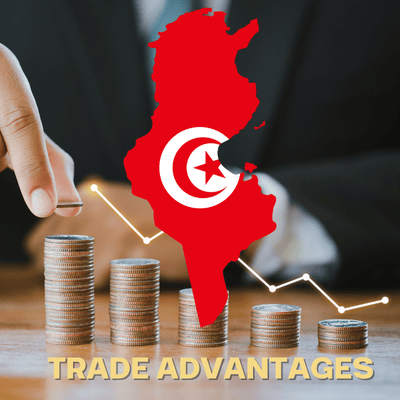4By1 Tunisia
Tunisia’s Trade Advantages
Strategic Geographical Location
- Tunisia is located at the crossroads of Europe, Africa, and the Middle East.
- Its Mediterranean coastline allows for 2–3 day shipping routes to Europe.
- Ports such as Sfax, Rades, and Bizerte are among the most active trade hubs in North Africa.
- This strategic position makes Tunisia an ideal logistics, production, and export hub.
Extensive Trade Agreements Network
- Tunisia was the first African country to sign a Free Trade Agreement (FTA) with the European Union (1995).
- Additionally, Tunisia is a member of:
- Greater Arab Free Trade Area (GAFTA)
- African Continental Free Trade Area (AfCFTA)
- Has special trade agreements with Turkey, the EU, the US, and COMESA countries
- This allows Tunisian-made products to access a very wide market duty-free.
Modern Infrastructure and Industrial Zones
- The country hosts more than 30 industrial and free trade zones.
- Modern production facilities exist for textiles, automotive, chemicals, electronics, and food industries.
- A rapidly developing logistics, port, and road network supports international trade.
Competitive Cost Advantage
- Labor costs are much lower than in Europe, while maintaining high quality.
- Energy, rent, and production expenses are 30–50% lower than in Europe or Gulf countries.
- This significantly reduces production costs for investors.
Political and Economic Stability
- Tunisia is one of the most stable and reform-oriented countries in North Africa.
- The investment environment is considered investor-friendly by international organizations such as the World Bank, IMF, and EBRD.
- The government offers incentives and tax advantages to support foreign investors.
Tunisia’s Strong Points in Trade (Advantages)
| Advantage | Explanation & Source | Impact for Investors / Trade Fair Presentation |
|---|---|---|
| Preferential Trade Agreements with the EU | Tunisia has agreements similar to a free trade regime with the EU, enabling easier access for products to European markets. | Provides export advantages to Europe for sectors such as textiles, machinery, and home textiles. |
| Export-Oriented Industrial Structure | Manufacturing products dominate exports; 75% of total exports come from the manufacturing sector. | Strong sub-sector foundation for production facilities and industrial investments. |
| Diverse Supplier Options | Tunisia imports from multiple countries; machinery and textile equipment are key import items. | Facilitates technology transfer and equipment import from international sources. |
| Port and Infrastructure Development Needs | Infrastructure improvement projects are underway; port modernization and strengthened logistics connections are planned. | Reduces logistics costs and speeds up distribution, enhancing competitive advantage. |



